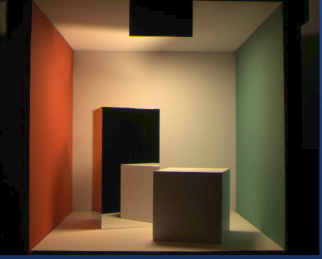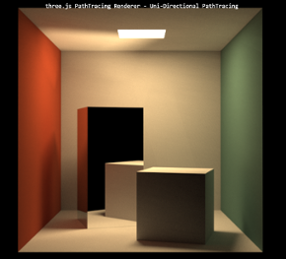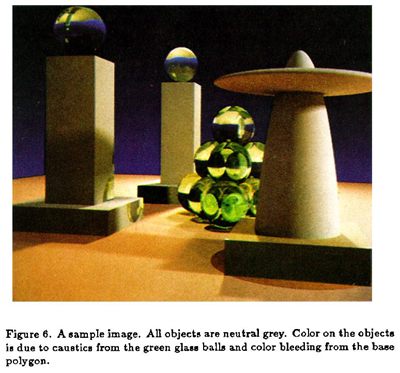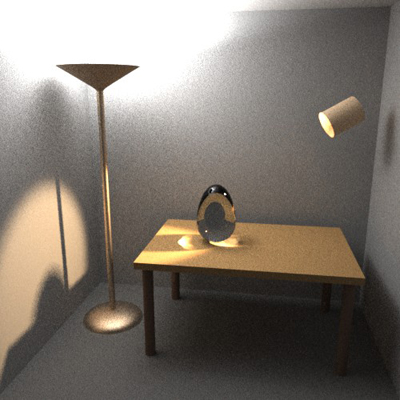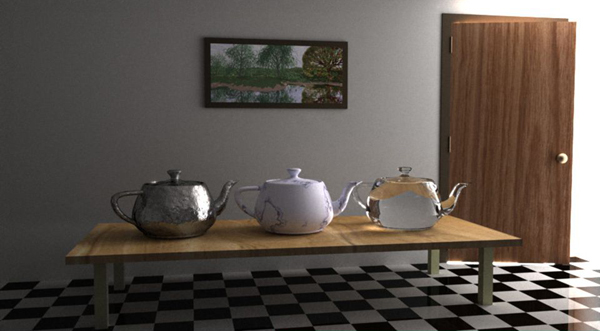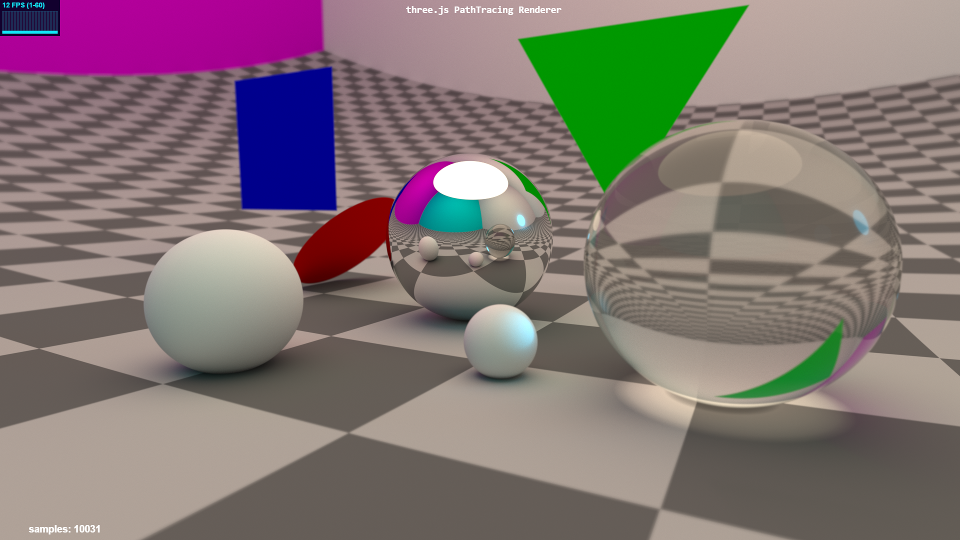THREE.js-PathTracing-Renderer
Real-time PathTracing with global illumination and progressive rendering, all on top of the Three.js WebGL framework.
LIVE DEMOS
-
Geometry Showcase Demo demonstrating some primitive shapes for ray tracing.
-
Billiard Table Demo shows support for image textures (i.e. .jpg .png) being loaded and used for materials (the billiard table cloth and two types of wood texture images are demonstrated).
-
Terrain Demo combines traditional raytracing with raymarching to render stunning outdoor environments in real time! Land is procedurally generated, can be altered with simple parameters. Total number of triangles processed for these worlds: 2! (for screen size quad) :-)
-
Cornell Box Demo which renders the famous Cornell Box, but at ~60 fps!
For comparison, here is a real photograph of the original Cornell Box vs. a rendering with the three.js PathTracer:
-
Multi-Method PathTracing Demo This is a new real-time path tracing method of my own. It combines 3 different rendering approaches in the same frame (regular camera-path tracing with direct lighting (as above), light-path tracing to assist the darker areas in shadows (see bi-directional section below), and my own caustics-path tracing algorithm to help mirror/glass caustics converge much faster). I'm pleased with the results - this is the fastest-converging Cornell Box scene with mirror specular caustics that I've seen anywhere. And it's all done with Webgl and the browser! (try it on your phone/tablet!) ;-)
-
Volumetric Rendering Demo renders objects inside a volume of dust/fog/etc.. Notice the cool volumetric caustics from the glass sphere on the left, rendered almost instantly!
-
Ocean and Sky Demo which models an enormous calm ocean underneath a realistic physical sky. Now has more photo-realistic procedural clouds!
-
Water Rendering Demo Renders photo-realistic water and simulates waves at 60 FPS. No triangle meshes are needed, as opposed to other traditional engines/renderers. In fact, not a single triangle was harmed during the making of this water volume! It is done through object/ray warping. Total cost: 1 ray-box intersection test!
-
Quadric Geometry Demo showing different quadric (mathematical) shapes (Warning: this may take 7-10 seconds to load/compile!)
Constructive Solid Geometry(CSG) Museum Demos
The following demos showcase different techniques in Constructive Solid Geometry - taking one 3D shape and either adding, removing, or overlapping a second shape. (Warning: these demos may take 10 seconds to load/compile!)
All 4 demos feature a large dark glass sculpture in the center of the room, which shows Ellipsoid vs. Sphere CSG.
Along the back wall, a study in Box vs. Sphere CSG: CSG_Museum Demo #1
Along the right wall, a glass-encased monolith, and a study in Sphere vs. Cylinder CSG: CSG_Museum Demo #2
Along the wall behind the camera, a study in Ellipsoid vs. Sphere CSG: CSG_Museum Demo #3
Along the left wall, a study in Box vs. Cone CSG: CSG_Museum Demo #4
Important note! - There is a hidden Easter Egg in one of the 4 Museum demo rooms. Happy hunting!
Materials Demos
These demos showcase different materials possibilities:
Materials Demo #1 Refractive (glass/water) and ClearCoat (billiard ball/car paint) materials
Materials Demo #2 Cheap Volumetric (smoke/fog/gas) and Specular (aluminum mirror) materials
Materials Demo #3 Diffuse (matte wall paint/chalk) and Translucent (skin/balloons,etc.) materials
Materials Demo #4 Metallic (Gold) and shiny SubSurface scattering (polished Jade/wax candles) materials
-
Classic Scenes
In 1986 James T. Kajiya published his famous paper The Rendering Equation, in which he presented an elegant unifying integral equation that generalizes a variety of previously known rendering algorithms. Since the equation is infinitely recursive and hopelessly multidimensional, he suggests using Monte Carlo integration (sampling and averaging) to converge on a solution. Thus Monte Carlo path tracing was born, which this repo follows fairly closely. At the end of his paper he included an image that demonstrates global illumination through path tracing:
And here is the same scene from 1986, rendered in real-time at 60 fps:
-
Bi-Directional Path Tracing
Nearly 20 years ago (Dec 1997), Eric Veach wrote a seminal PhD thesis paper on methods for light transport http://graphics.stanford.edu/papers/veach_thesis/ In Chapter 10, entitled Bi-Directional Path Tracing, Veach outlines a novel way to deal with difficult path tracing scenarios with hidden light sources (i.e. cove lighting, recessed lighting, spotlights, window lighting on a cloudy day, etc.). Instead of just shooting rays from the camera like we normally do, we also shoot rays from the light sources, and then join the camera paths to the light paths. Although his full method is difficult to implement on GPUs because of memory storage requirements, I took the basic idea and applied it to real-time path tracing of his classic test scene with hidden light sources. For reference, here is a rendering made by Veach for his 1997 paper:
And here is the same room rendered in real-time by the three.js path tracer:
The following classic scene rendering comes from later in the same paper by Veach. This scene is intentionally difficult to converge because there is no direct light, only indirect light hitting the walls and ceiling from a crack in the doorway. Further complicating things is the fact that caustics must be captured by the glass object on the coffee table, without being able to directly connect with the light source.
And here is that scene rendered in real-time by the three.js path tracer: Try pressing 'E' and 'R' to open and close the door!
I had the above images only to go on - there are no scene dimensions specifications that I am aware of. Since I don't have a working BVH acceleration structure just yet, I had to simplify the sculptures on the coffee table from Utah teapots to ellipsoids. However, I feel that I have captured the essence and purpose of his test scene rooms. I think Veach would be interested to know that his scenes, which probably took several minutes if not hours to render back in the 1990's, are now rendering real-time near 60 FPS on a web browser! :-D
For more intuition and a direct comparison between regular path tracing and bi-directional path tracing, here is the old Cornell Box scene but this time there is a blocker panel that blocks most of the light source in the ceiling. The naive approach is just to hope that the camera rays will be lucky enough to find a light source:
- Naive Approach to Blocked Light Source As we can painfully see, we will have to wait a long time to get a decent image! Enter Bi-Directional path tracing to the rescue!:
- Bi-Directional Approach to Blocked Light Source Like magic, the difficult scene comes into focus - in real-time!
FEATURES
- Real-time interactive Path Tracing in your Chrome browser - even on your smartphone! ( What?! )
- First-Person camera navigation through the 3D scene.
- When camera is still, switches to progressive rendering mode and converges on a photo-realistic result!
- The accumulated render image will converge at around 1,000-2,000 samples (lower for simple scenes, higher for complex scenes).
- Direct lighting now makes images render/converge almost instantly!
- Both Uni-Directional (normal) and Bi-Directional path tracing approaches available for different lighting situations.
- Support for: Spheres, Planes, Discs, Quads, Triangles, and quadrics such as Cylinders, Cones, Ellipsoids, Paraboloids, Hyperboloids, Capsules, and Rings/Torii. Parametric/procedural surfaces (i.e. terrain, clouds, waves, etc.) are handled through Raymarching.
- Constructive Solid Geometry(CSG) allows you to combine 2 shapes using operations like addition, subtraction, and overlap.
- Basic support for loading models in .obj format (triangle and quad faces are supported, but no higher-order polys like pentagon, hexagon, etc.)
- Current material options: Metallic (mirrors, gold, etc.), Refractive (glass, water, etc.), Diffuse(matte, chalk, etc), ClearCoat(cars, plastic, billiard balls, etc.), Translucent (skin, leaves, cloth, etc.), Subsurface w/ shiny coat (jelly beans, cherries, teeth, polished Jade, etc.), Volumetric (smoke, dust, fog, etc.)
- Materials can now use Texture images which can be loaded, applied, and manipulated in the path tracer
- Diffuse/Matte objects use Monte Carlo integration (a random process, hence the visual noise) to sample the unit-hemisphere oriented around the normal of the ray-object hitpoint and collects any light that is being received. This is the key-difference between path tracing and simple old-fashioned ray tracing. This is what produces realistic global illumination effects such as color bleeding/sharing between diffuse objects and refractive caustics from specular/glass/water objects.
- Camera has Depth of Field with real-time adjustable Focal Distance and Aperture Size settings for a still-photography or cinematic look.
- SuperSampling gives beautiful, clean Anti-Aliasing (no jagged edges!)
- Users will be able to use easy, familiar commands from the Three.js library, but under-the-hood the Three.js Renderer will use this path tracing engine to render the final output to the screen.
Experimental Works in Progress (W.I.P.)
The following demos show what I have been experimenting with most recently. They might not work 100% and might have small visual artifacts that I am trying to fix. I just wanted to share some more possible areas in the world of path tracing! :-)
Rendering spheres, boxes and mathematical shapes is nice, but most modern graphics models are built out of triangles. The following demo uses an .obj loader to load a model in .obj format (list of triangles) from disk and then places it in a scene to be path traced. As of now, it runs too slow for my taste. It still needs a BVH acceleration structure to speed things up greatly (I am currently investigating different approaches on the GPU). I am showing this because I wanted to demonstrate the ability of the three.js PathTracing renderer to load and render a model in one of the most popular model formats ever:
I now have a working BVH (Bounding Volume Hierarchy) builder. It builds a nested set of bounding boxes to avoid having to test every single triangle in the scene. Scenes which used to render at 10 FPS are now rendering at 50-60 FPS! For BVH test purposes, I randomize the branch that the ray takes when it is traversing the array of Bounding Boxes. Hence the following demo, which renders the triangle model as more of a 'point cloud' than a solid object. This is because the rays are taking random branches since in WebGL 1.0, I can't keep a stack with dynamic indexing like Boxes[x].data where x is the correct branch. But at least the model is loading and rendering very quickly. I just have to figure out how to access the arrays of boxes somehow so that the ray always takes the correct branch, and backs up and takes the other fork if it fails. In the meantime, enjoy the famous Utah Teapot which has nearly 1000 triangles! :D
Some pretty interesting shapes can be obtained by deforming objects and/or warping the ray space (position and direction). This demo applies a twist warp to the spheres and mirror box and randomizes the object space of the top purple sphere, creating an acceptable representation of a cloud (for free - no extra processing time for volumetrics!)
Updates
- March 6th, 2018: I recently developed a new approach to real-time rendering of scenes containing caustics (bright spots on diffuse surfaces from specular reflections/refractions - i.e. mirrors, metal jewelry, glass objects, swimming pools, etc.). I nicknamed it 'Multi-Method' path tracing - it uses 3 different methods to render the final image each frame. It starts out with regular traditional camera-path tracing with Direct Lighting samples. However, not all areas can see the light source for the Direct Light contribution, and they remain in shadow and noisy. So to assist these darker areas, I employ light-path tracing to get the light out and into these hidden areas of the scene. Lastly I use a method of my own creation, caustic-path tracing to help along the diffuse areas that are brightened by specular reflections/refractions. Typically these areas are the slowest to converge in any renderer, even for high-end software like Octane, Cycles, V-Ray, etc.. So to help these areas converge quickly, I store the hit point on a diffuse surface from the 1st loop (the regular camera-path tracing loop). Then I use that hit point as a caustic ray starting point. I pick a random point on the object(s) giving caustics, and trace for a bounce depth of 2. If the caustic-finding ray hits the specular surface on the first bounce, it continues with 1 more bounce in hopes of finding the light source. If it does not find anything bright, no contribution is made to the final pixel color. If it finds the light source, it brightens the pixel accordingly with diffuse cosine attenuation falloff. The result is caustics that resolve in a matter of seconds rather than minutes! This method is still in the experimentation stage, I have to see if it will work for multiple glass/metal caustic-giving objects in a scene. But the initial results are promising!
- February 21st, 2018: Added support for procedural landscapes through raymarching. Traditional ray tracing works well for mathematical shapes such as spheres, cones, triangles, etc., but would be too slow or unsolvable for complex shapes such as mountain terrain, clouds, etc.. Therefore Raymarching through heightfields, through distance fields, and through 3d noise is usually employed to deal with these scenarios. Also known as 'sphere' tracing, the basic technique is: instead of firing a thin ray at the scene objects, we shoot out a sphere of conservative size only a little ways out, advancing in calculated steps so we don't miss any important details. At each raymarch step, the distance is evaluated from the center of the sphere to the object in question. In the case of terrain in an XZ plane (Y is height), the height of the test sphere location, its Y position, is compared with the height of the terrain, terrain Y, at that same X Z position of the sphere. If you have a texture heightmap for instance, you just use the sphere X and Z to look up the texture coordinates X,Y(sphere Z), read the value at that texture pixel, and make it the terrain Y value at that particular location. If the sphere is 'above' the terrain, keep going, this time moving forward the same distance from the last comparison. If the sphere is 'beneath' the terrain, stop - you have located the surface. Sorry for the slowness of updates, but I had to wrestle with understanding this technique and making it run at 30 FPS, even on a cell phone. I must have stopped and restarted the technique from scratch about 5 times and almost abandoned it at one point. But I'm glad I stuck with it because the Terrain Demo results are beautiful and immersive!
- November 27th, 2017: I recently added 2 classic scenes demos - a Difficult Lighting scene from Eric Veach's thesis, and The Rendering Equation scene from Kajiya's famous 1986 paper. These classic scenes are a good fit for the three.js path tracer because they have relatively few objects and simple shapes, which we can render real time without a dedicated geometry acceleration structure (like a BVH, that is still a WIP). Even though they are simple in their composition, they usually contain a special light transport problem that must be solved quickly and correctly. With modern GPUs, we can now render in 16 milliseconds what used to take minutes, if not hours, back in the late 80's and early 90's. I personally had a lot of fun recreating these scenes just from one old image - it gives me a sense of connection with our CG heroes of the past! :)
- October 3rd, 2017: Major strides have been made in the Bi-Directional path tracing area. Difficult scenes (due to hidden light sources) which used to take minutes if not hours to come into focus, are now running at 60 FPS and converging under a minute, sometimes within seconds! Check out the new Bi-Directional scene demos above. In Eric Veach's (co-inventor of the Bi-Directional method) original algorithm, he kept a stack of camera path data as well as light path data, then chose different combinations of those 2 paths, depending on the effeciency they had on desired visual effects of the particular scene at hand. This is not well-suited for GPUs because of the memory stack requirements, so I simplified the full algorithm down to what I'm calling Quasi Bi-Directional path tracing. Instead of keeping a stack of all the possible paths, I simply join the random camera path to the random light path at the end of the ray tracing loop. It runs so fast that all the desired effects eventually come into focus, which makes it possible for real-time games in the future where the game character might be in a dimly lit room. I might put my simplified real-time algorithm to the ultimate test and try to render this scene: https://erichlof.github.io/THREE.js-PathTracing-Renderer/readme-Images/Ref.png Eric Veach had to resort to his novel Metropolis Light Transport (MLT) to deal with this super-difficult lighting situation. Just for fun, I may want to see how my lowly quasi bi-directional method stacks up! ;-)
- April 21st, 2017: Major rendering engine update across all demos - more FPS and more photo-realism! Also I have a working BVH builder for triangle models! Check out the 'BVH debugging' demo above. The BVH data structure has sped up triangle models greatly - I'm getting around 60 fps for low poly models under 1000 triangles! However, rendering them is another story: I've hit a wall with the current WebGL 1.0 shader language (GLSL): It doesn't allow accessing an array with a variable, like you can easily do in other languages. For example, vec3 myBoxesData[64]; int x = 13; float correctNode = myBoxesData[x]. The statement with myBoxesData[x] fails under the current implementation of WebGL 1.0 (It must be a constant like '2' or something). Hopefully this won't be an issue when Three.js moves over to WebGL 2.0, which does support dynamic indexing of arrays. But in the meantime, I'm trying to figure out a workaround. Also I've been experimenting on the side with rendering fluids like water, oil, milk, etc. I'll post something as soon as I get it working! :)
- March 3rd, 2017: Complete overhaul of mobile joystick controls. Now the controls on Cell Phones and Tablets have a smooth, fluid response. Also I changed the look of the buttons to directional, which makes more sense in this fly-cam setting. However, I left the vintage joystick arcade-style circular buttons code intact, but commented out, so if you want a character jump-action button, etc., you can just mix and match the button shapes to your liking! :-)
TODO
- Add support for layered texture materials (diffuse, normal map, specular map, emissive map, etc.)
- Instead of scene description hard-coded in the path tracing shader, let the scene be defined using the Three.js library
- Debug BVH branching - figure out a way around dynamic array index ban in WebGL 1.0, or wait until 2.0 support in three.js
- Dynamic Scene description/BVH updating and streaming into the GPU path tracer via Data Texture.
ABOUT
- This began as a port of Kevin Beason's brilliant 'smallPT' ("small PathTracer") over to the Three.js WebGL framework. http://www.kevinbeason.com/smallpt/ Kevin's original 'smallPT' only supports spheres of various sizes and is meant to render offline, saving the image to a PPM text file (not real-time). I have so far added features such as real-time progressive rendering on any device with a Chrome browser, FirstPerson Camera controls with Depth of Field, more Ray-Primitive object intersection support (such as planes, triangles, and quadrics), and support for more materials like ClearCoat and SubSurface.
This project is in the alpha stage. More examples, features, and content to come...
